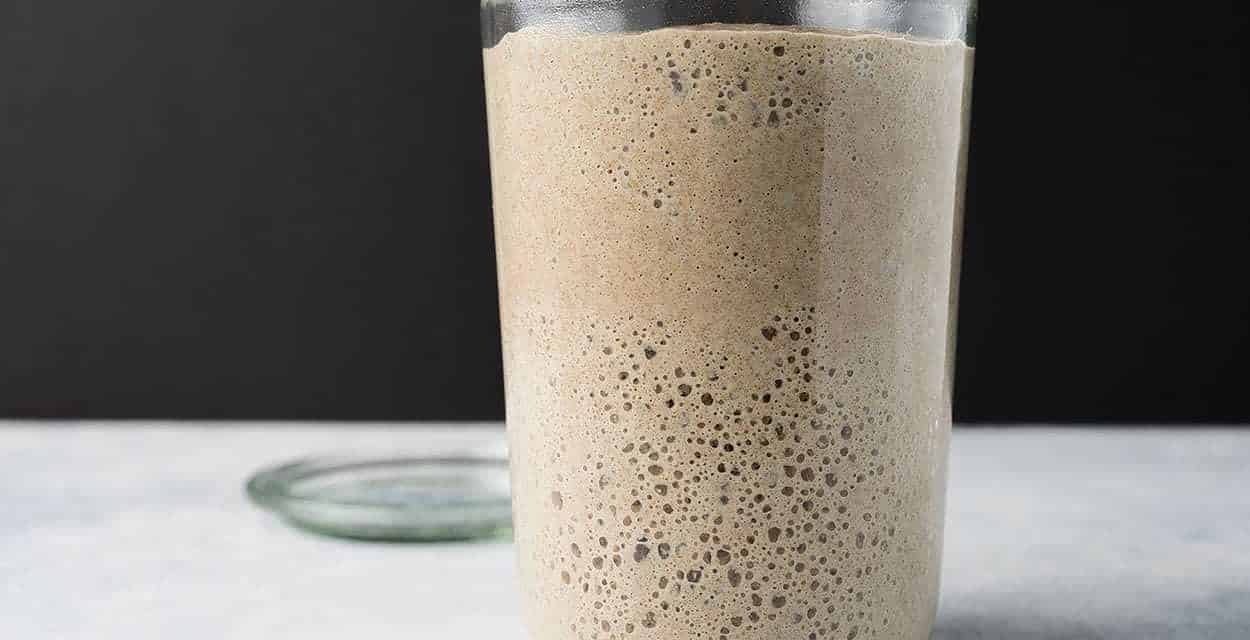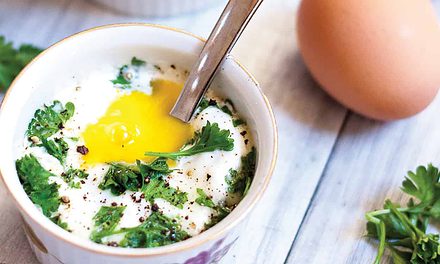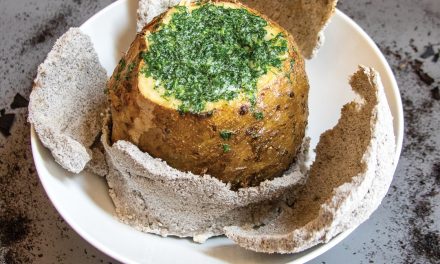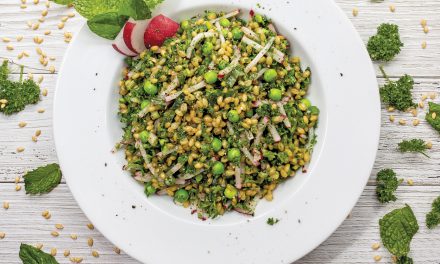Three Basic Ingredients
Story and photos by Maurizio Leo


Flour, water, salt. That’s it. Nothing more, nothing less. If you had told me several years ago that I could make enticingly crunchy, tender, healthy bread at home with only these elemental ingredients, I would not have believed you. I would have claimed that baking bread requires a professional mixer, a big oven, and a list of ingredients so long your eyes start to glaze over. And yet, I’m performing this alchemy day after day in my home kitchen: transforming three basic ingredients into wholesome sourdough bread.
How does one begin the journey of making naturally leavened bread? It starts with, well, a sourdough starter.
Despite all the mysticism and lore about creating the concoction, when broken down, it’s simply a naturally fermenting mixture of flour and water. Add water to dry flour and let it sit on the counter for a few days, and you’ll see nature weave life into a once lifeless lump: bubbles will appear, and the mixture will rise. This natural fermentation can be harnessed, and, once stable, controlled to produce a bread so flavorful and healthy that it’s hard to go back to anything else.
I created my sourdough starter (aptly named Brutus after the trouble it gave me in the beginning) more than five years ago, and it’s the same one I use to this day. It’s a spoiled brat now, to be sure, but in exchange for my attention and fresh flour, it stays on schedule and, when baking, it does most of the heavy lifting (bread-nerd joke, sorry). Back in the early days, it was the quintessential rebellious child: sometimes it wouldn’t show any fermentation activity, and at other times it was utterly unruly. In the beginning, I didn’t realize what it needed to thrive; I didn’t see how important timely refreshments (mixing in fresh flour and water) were, or how much temperature impacts fermentation. The key to raising a well-adjusted starter is to be observant of its needs, give it space to grow, and adjust refreshments to encourage maximum fermentation activity. A healthy starter means great bread.
Creating a healthy starter can be done in as few as six to seven days, requiring only a small amount of attention each day. But first, we need to pick up a few key ingredients:
- a kitchen scale
- whole grain, dark rye flour (organic, if possible)
- unbleached all-purpose flour (organic, if possible)
- a small spatula
- two 1-liter glass, or plastic, jars with loose fitting lids
A kitchen scale guarantees accuracy when measuring the amount of flour needed for each starter refreshment. Measuring flour by volume is inherently imprecise as the amount of flour packed into a measuring cup can vary. Further, it’s a good idea to get used to using a scale for weighing ingredients as this will improve future baking consistency.
Why rye flour? Rye flour is teeming with extra nutrients and microorganisms that help kickstart the whole process. If you don’t have rye flour, a good quality whole wheat will also work well.
A few tips before beginning
- Water that’s high in chlorine can impede fermentation. Before starting this process, fill a large jug with tap water and let it sit out uncovered overnight to let any chlorine dissipate. Alternatively, distilled water could be used in lieu of tap water.
- After you put your starter mixture in the jar, you will keep it covered, but not sealed, during the rest of the process. Either a porous cloth or a lid resting on top of the jar will work well. Use containers with enough headspace for the mixture to rise. Additionally, place your jar in a bowl while it’s resting in case the mixture spills over.
- There’s often a surge in fermentation activity during the first couple days of the process, probably caused by other yeast and bacteria that will eventually die off. When this happens, many attempting to create a sourdough starter think it has “died,” and they start over. Don’t be fooled by this lapse in activity; continue with the schedule and eventually the desired yeast and bacteria will move in and stabilize.
- The entire process is extremely temperature-dependent. By keeping the contents of the jar around 80ºF, you’ll ensure a favorable environment and speed things up dramatically. If you have a home proofer or yogurt maker, this would be the time to turn it on. If not, a home oven, turned off, with the light on inside (and a thermometer to monitor the temperature) will work well.

Day one
In the morning, measure 100 grams whole grain rye flour and 150 grams water, and mix together in one of the jars. Stir vigorously until all dry bits are incorporated. Keep this mixture somewhere warm in your kitchen—80–85ºF is ideal. If it’s cool in your kitchen, warm the water to 80ºF before mixing. Let the mixture rest out of direct sunlight for 24 hours.
Day two
You may or may not already be seeing some activity. As mentioned above, this potential surge of activity is normal and should subside around day three.
Place your second, empty jar on the scale and tare so that it reads 0 grams. Scoop in 75 grams of the mixture that has been resting for 24 hours, discarding the rest. Next, add 50 grams rye flour, 50 grams all-purpose white flour, and 125 grams water (again, if it’s cold, warm the water to 80°F). Mix well until all dry bits are incorporated, cover, and place in the same warm spot for 24 hours, until day three. Empty and clean the jar from day one.
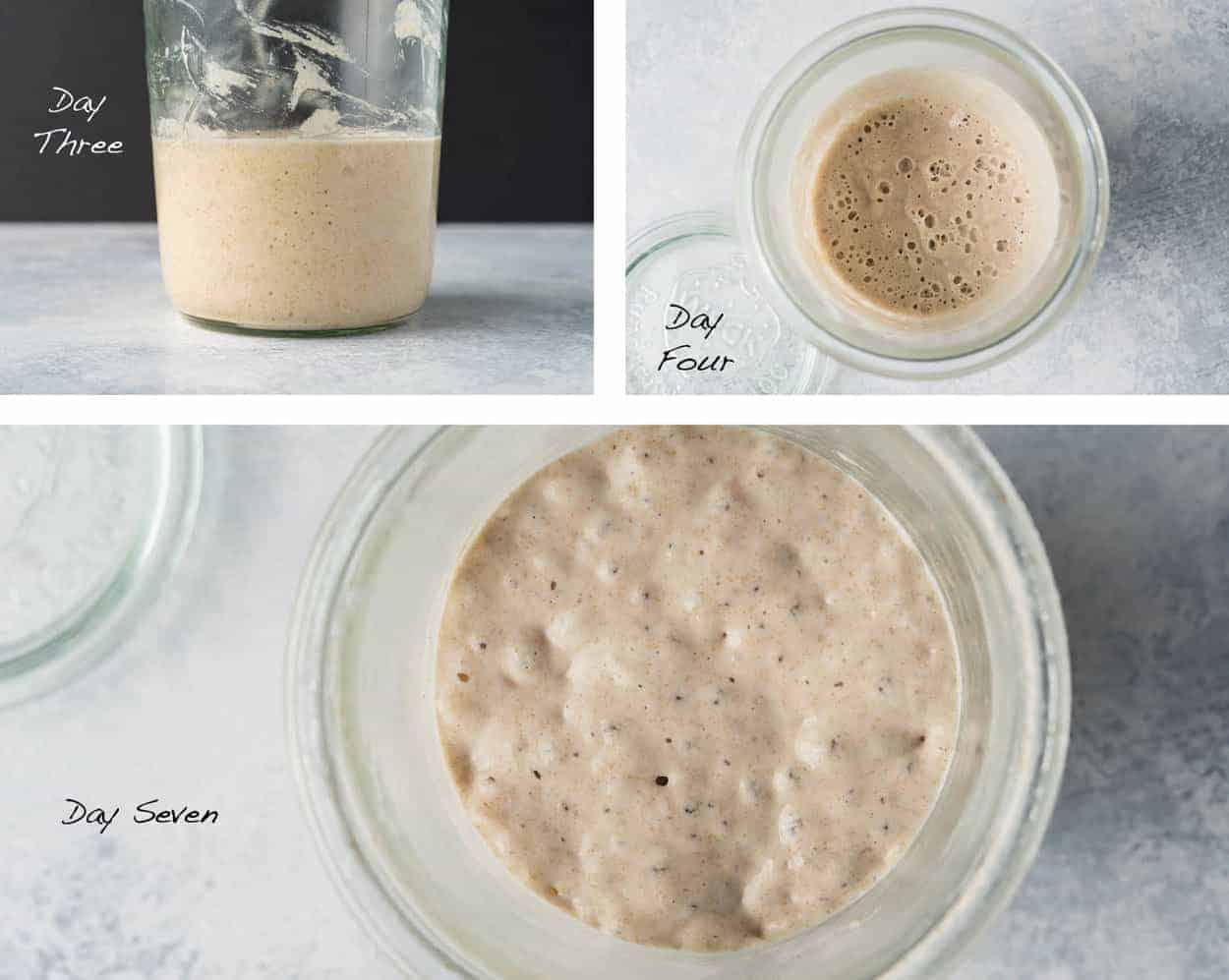
Day three
In the morning, you may start to see more activity, or you may see none. Don’t fret; stick to the schedule, and activity will pick up soon enough.
Regardless of activity, place your clean jar on the scale and tare. Scoop in 75 grams of the mixture that rested overnight and add 50 grams rye flour, 50 grams white flour, and 125 grams warm water. Stir until well incorporated. Cover the jar and let rest 24 hours until day four. Discard the rest of the mixture in the first jar and clean it in preparation for the next day.
Day four
This is the first day of the process with two refreshments in a single day: one in the morning, and one approximately 12 hours later.
In the morning, you should start to see signs of fermentation activity if you haven’t already. There will be bubbles scattered on the sides and top, and the level of the mixture might have risen and fallen a little (evidenced by streaks on the sides of the jar).
Refresh as on day three. Place a clean jar on the scale and tare. Scoop in 75 grams of the mixture from the jar that fermented overnight; add 50 grams rye flour, 50 grams white flour, and 125 grams warm water (80ºF). Mix thoroughly, cover, and let rest for 12 hours. After this 12-hour rest, refresh again with the same ratio of ingredients, and let rest overnight.
Days five and six
For days five and six, continue refreshing with the same ratio of ingredients as day four, twice a day, as fermentation activity increases more and more.
Days seven and onward
In the morning on day seven, place a clean jar on the scale and tare. Scoop in 50 grams of the mixture from the jar that fermented overnight. To this, add 100 grams all-purpose flour and 100 grams warm water (no rye flour is needed). Mix thoroughly, cover, and let rest for 12 hours. In the evening (after about 12 hours), refresh again with the same ratio of ingredients and let rest until the next day.
At this point you should start to see the height of your starter rise and fall in the jar predictably each day. This periodic behavior is a good indicator that it is strong enough to use for your first loaf of bread. If your starter is still struggling to show vigorous activity, keep refreshing with the same ratio of ingredients for another day, or several more, until things pick up. This process can sometimes take longer, depending on the flour used and the environment (especially if it’s cool in your kitchen). Be patient and stick to the schedule, and eventually a stable starter will take hold.
The starter will continue to develop flavor and strength over the next week and into the future. With a strong starter, you can now use a portion of it when “mature” (when it’s risen to maximal height) to make a leaven (or levain) for the bread recipe to follow.
If you need a break from refreshing your starter each day, you can always stick it into the refrigerator for a week (or up to two in a pinch) right after a refreshment. When you want to bake again, take it out a few days before and give it 2–3 refreshments over the course of a day or two to get it back up to strength.
These days, refreshing my sourdough starter has become a liturgical part of my day. It takes mere minutes to provide it with fresh flour and water, and in return it produces incredibly flavorful and healthy sourdough bread for my family. I like to think it’s me making the bread—I’m controlling fermentation, my hands are mixing, and my hands shape the dough—but the reality is that I’m just a small cog in nature’s machinery. All I really need to do is lend a helping hand and stay out of the way.
Time to make THE PERFECT LOAF: Recipe for BEGINNER’S SOURDOUGH BREAD

Edible celebrates New Mexico's food culture, season by season. We believe that knowing where our food comes from is a powerful thing. With our high-quality, aesthetically pleasing and informative publication, we inspire readers to support and celebrate the growers, producers, chefs, beverage and food artisans, and other food professionals in our community.

